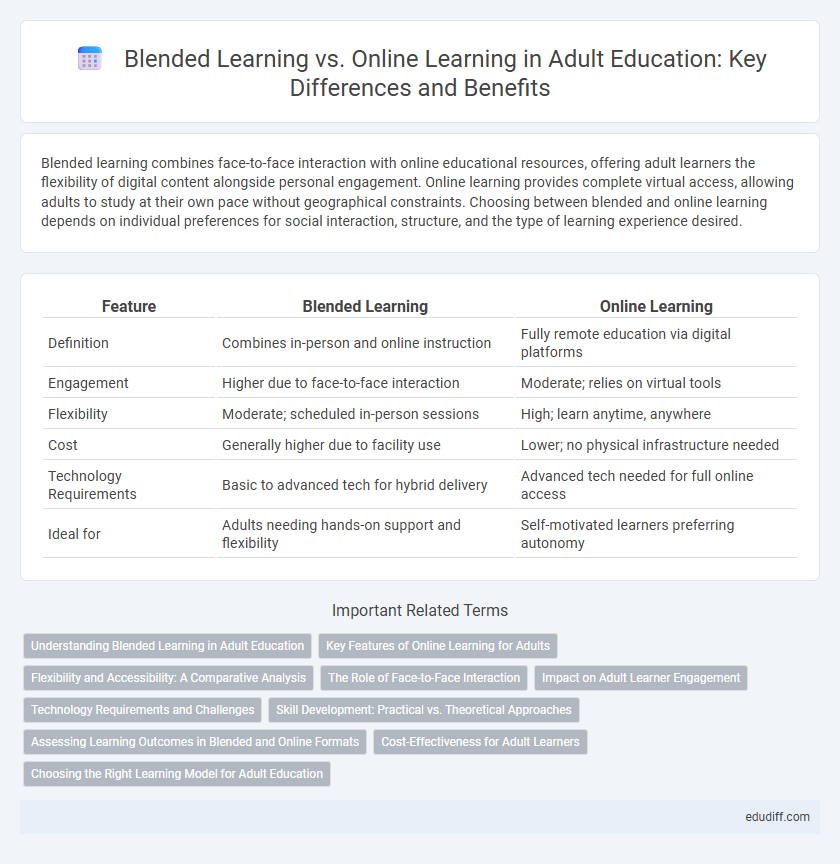Blended learning combines face-to-face interaction with online educational resources, offering adult learners the flexibility of digital content alongside personal engagement. Online learning provides complete virtual access, allowing adults to study at their own pace without geographical constraints. Choosing between blended and online learning depends on individual preferences for social interaction, structure, and the type of learning experience desired.
Table of Comparison
| Feature | Blended Learning | Online Learning |
|---|---|---|
| Definition | Combines in-person and online instruction | Fully remote education via digital platforms |
| Engagement | Higher due to face-to-face interaction | Moderate; relies on virtual tools |
| Flexibility | Moderate; scheduled in-person sessions | High; learn anytime, anywhere |
| Cost | Generally higher due to facility use | Lower; no physical infrastructure needed |
| Technology Requirements | Basic to advanced tech for hybrid delivery | Advanced tech needed for full online access |
| Ideal for | Adults needing hands-on support and flexibility | Self-motivated learners preferring autonomy |
Understanding Blended Learning in Adult Education
Blended learning in adult education combines traditional face-to-face instruction with online digital resources, enhancing flexibility and engagement for adult learners. This approach supports diverse learning styles and allows adults to balance education with personal and professional responsibilities more effectively than purely online formats. Research shows that blended learning improves retention and practical application by integrating interactive content and real-world experiences tailored to adult education needs.
Key Features of Online Learning for Adults
Online learning for adults offers flexible scheduling, allowing learners to access course materials anytime to balance education with work and family commitments. Interactive multimedia content and discussion forums provide engaging, self-paced learning experiences tailored to diverse adult learning styles. Robust support systems, including virtual tutors and peer networks, enhance knowledge retention and motivation throughout the online education journey.
Flexibility and Accessibility: A Comparative Analysis
Blended learning offers flexible scheduling by combining in-person and online sessions, allowing adult learners to balance education with work and personal responsibilities effectively. Online learning provides unparalleled accessibility, enabling students to access course materials from any location at any time, which is ideal for those with geographical or time constraints. Both approaches enhance learning adaptability, yet blended learning fosters greater structure through face-to-face interaction, while online learning maximizes convenience and self-paced study.
The Role of Face-to-Face Interaction
Face-to-face interaction in blended learning enhances adult learners' engagement by fostering immediate feedback, social presence, and collaborative problem-solving that online learning alone often lacks. Physical classroom settings support non-verbal cues and spontaneous discussions, which improve comprehension and motivation among adult students seeking practical knowledge application. While online learning offers flexibility, integrating in-person sessions creates a balanced environment optimizing retention and interpersonal skill development crucial for adult education.
Impact on Adult Learner Engagement
Blended learning enhances adult learner engagement by combining face-to-face interaction with digital resources, fostering deeper comprehension and collaboration. Online learning offers flexibility and self-paced study, appealing to adults balancing education with personal and professional responsibilities. Research indicates that the interactive components of blended learning significantly increase motivation and retention among adult students compared to fully online formats.
Technology Requirements and Challenges
Blended learning demands a combination of physical classroom resources and reliable digital infrastructure, including devices capable of supporting interactive software, stable internet connections, and learning management systems (LMS). Online learning relies heavily on technological tools such as video conferencing platforms, digital content delivery, and real-time assessment software, making bandwidth stability and device compatibility critical factors. Challenges include addressing digital literacy gaps, ensuring equitable access to technology, and managing cybersecurity risks within both learning environments.
Skill Development: Practical vs. Theoretical Approaches
Blended learning combines online theoretical instruction with in-person practical activities, enhancing skill development by allowing learners to apply concepts in real-time environments. Online learning primarily offers theoretical knowledge through virtual lectures and digital resources, which can limit hands-on experience crucial for mastering complex skills. This hybrid model effectively bridges the gap between conceptual understanding and practical application, leading to more comprehensive adult education outcomes.
Assessing Learning Outcomes in Blended and Online Formats
Assessing learning outcomes in blended and online formats requires tailored strategies to accurately measure student performance and engagement. Blended learning assessments often combine in-person evaluations with digital quizzes and project-based tasks, leveraging the benefits of both environments to provide comprehensive feedback. Online learning assessments prioritize interactive tools such as automated tests, discussion participation, and multimedia assignments to ensure consistent and scalable evaluation of student progress.
Cost-Effectiveness for Adult Learners
Blended learning offers adult learners a cost-effective solution by combining online digital media with traditional face-to-face instruction, reducing commuting and material expenses. Online learning eliminates location-based costs entirely, providing flexibility and access to a wide range of affordable or free resources. Both methods significantly lower the overall cost of education compared to traditional classroom-only models, making skill acquisition more accessible for adults balancing work and personal commitments.
Choosing the Right Learning Model for Adult Education
Blended learning combines face-to-face interaction with digital resources, offering adult learners flexibility and personalized support that enhances retention and engagement. Online learning provides complete accessibility and self-paced study, making it ideal for adults balancing work, family, and education commitments. Selecting the right model depends on individual learning preferences, technological access, and the need for social interaction or immediate feedback in skill development.
Blended Learning vs Online Learning Infographic

 edudiff.com
edudiff.com